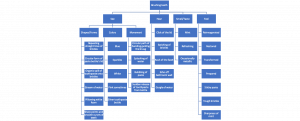2110
Sensory Experience 3 Dimensional Component
I used foam core board and bristle paper to elevate components of the organic shapes. I kept the shapes white and raised the to various heights. I felt that these were a focal point in the piece because they show the finished cleanliness that comes with the brushing. I wanted the white blobs to come out of the poster as way to say, “hey, look how fresh and clean we are!”.
Sensory Experience Developement
I developed my prototype with the use of the blue as my only color. The blue is representational of the toothpaste; however, the different shades and tints of the same hues emphasize the transformation that from gross and dingy to light and clean. I use the darkest blue to push the sensation of the sharp mint cutting into one’s taste buds. I made the swirled shapes softer and less intense as they present the constant circular movement during the process. Lastly, the organic forms (originally plain white circles) were added into order to express the change in the tooth paste as it coats the teeth. I also included the frames to present the viewer with the message of contained chaos. Notice how the patterns circle each other- this was done to remind the audience that this is a daily process that is included in the cycle of most. The final adjustment of the perspective intent is to prevent the design from being too static. Brushing teeth is a mindless, simple act, yet the toothbrush, paste, and water involve are is constant motion and change. The perspective makes it more dynamic.
Sensory Experience Iterations
Sensory Experience Brainstorm

Imagined Journey Brainstorm
Initially, I knew I wanted to create some type of drawn form of my journey. I felt shoes would be the best representational character for this as it is a relatable item essential to travel. I have never animated something before, so I knew it would be a lot of experimenting with the software I have access to (mainly photoshop and iMovie). My end product changed a lot from my original plan. Overall, the essence of my journey- feeling lost but finally succeeding- stayed to the same regardless of plot.
Pattern and Scale Construction
Depth
The following scans are my ideations for depth. I thought about how direction can be used to emphasize the feeling of depth. The circular build of a cone was considered throughout most of these ideations. I used this idea when creating a spiral leading downward in my depth construction. It was not necessarily a cone, yet that was the inspiration. I used a combination of parts to plan my final design. I appreciated the concentric circles as they highlighted the various scaled circles in my design, but I decided to use the sharp triangular components sparingly in my finalized build. This was done as the triangles purposes were purely decorative. The motion emanating from the spiraled circles focalizes the centered design. I used depth for this emphasized point.
This is a demonstration of how the combination of the spiraled circles and the centered design will interact. It will grow outward to produce the polar effect of drawing the audience inward. I separated the components by keeping the triangle parts only on the center piece. The layers will be stacked using pillars of chip board and each other for support.
Volume
Ideation number six for volume was my initial plan for the volumetric design. I planned to fill the space with variations of my design, rooting the new construction in the individual components. I determined to create the sense of volume by building up the layers (opposite to how I broke down the circles for depth). Balance is another essential component for this design. I maintained balance in this asymmetric piece by having the focal point be the large, completed design with small partially created designs surrounding it. The variation in heights helped produce a full, voluminous design as it contrasts with the flat layers building up to it.


Color and Pattern Finalization

Mountain Process


Frog Eye Process



























